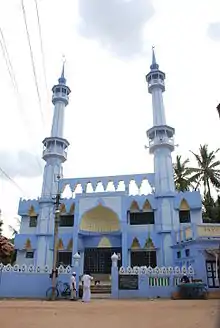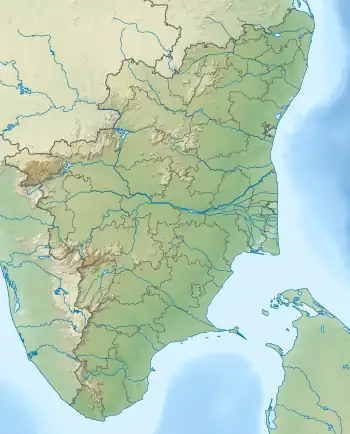| Muhyuddin Andavar Mosque مسجد سيد محي الدين | |
|---|---|
முஹ்யுத்தீன் ஆண்டவர் பள்ளிவாசல் | |
 Muhyuddin Andavar Mosque in daytime | |
| Religion | |
| Affiliation | Sunni Islam |
| District | Thanjavur |
| Region | South India |
| Rite | Hanafi |
| Leadership | Nattamai |
| Year consecrated | 1989 (rebuilt) |
| Status | Active |
| Location | |
| Location | |
| Cercle | Thiruvidaimarudur |
| State | Tamil Nadu |
 Location of the mosque | |
| Geographic coordinates | 11°05′13″N 79°27′00″E / 11.087033°N 79.449888°E |
| Architecture | |
| Type | Mosque |
| Style | Indo-Islamic |
| Funded by | Fundraising and Donation |
| Completed | 1989 (rebuilt) |
| Specifications | |
| Direction of façade | Qibla |
| Capacity | 500 |
| Dome(s) | 0 |
| Minaret(s) | 2 |
| Minaret height | 25 m (82 ft) |
| Shrine(s) | 1 ('Abd al-Rahman Baksh) |
| Inscriptions | Arabic calligraphy |
| Website | |
| www.muhyuddin.in | |
Muhyuddin Andavar Mosque (Tamil: முஹ்யுத்தீன் ஆண்டவர் பள்ளிவாசல் - Muḥyuddīn Āndavar Pallivāsal, Arabic: مسجد سيد محي الدين - Masjid Sayyid Muhyu-d Din, English: Saint Muhyuddin Mosque) is the only congregational mosque in the town of Thiruppanandal in the Thanjavur district of Tamil Nadu, India. It is administered according to the Sunni-Hanafi school of jurisprudence. It is part of a complex that houses a mausoleum, a cemetery, and a number of shops that are rented out to generate income for the running of the mosque.
History
In the early 80's, the old Mosque was torn down and re-built in the current form. The inauguration of the new mosque was held on Friday, 3 February 1989.
Mosque Architecture
The mosque follows the architecture of South Indian mosques that were built or re-built in the 20th century with some notable exceptions. Externally, the mosque is fronted by two minarets. Curiously there is no dome. To the right is the traditional pool used for Wudu and a side entrance to the graveyard.
Internally, the mosque is two storeys high. The ground floor houses the inner prayer hall where the Congregational prayers are performed. It is surrounded by a cloister and an outer prayer hall where town meetings, religious discourses, wedding ceremonies, and dhikr gatherings are held.
Another unique aspect of the mosque is the absence of a physical Minbar or pulpit. Instead, there is a hidden passageway from the Mihrab or prayer niche that leads to a balcony that extends out. The Khatib or prayer leader delivers the Khutba or sermon from here.
The Mausoleum
At the entrance of the mosque complex is the mausoleum of a celebrated Faqir, Sheikh Abdur Rahman Baksh (Arabic: عبد الرحمن بكش - Abdu-r Raḥmān Baksh, Tamil: மஸ்தான் சாஹிப் வலியுல்லா - Mastān Ṣāḥib Waliyullah). His Urs or anniversary is celebrated with pomp and fanfare on the Islamic calendar date of 22 Rabi al-Awwal.
His resting abode is taken as a source of immense blessings (Arabic: بركة - Barakah, Tamil: பரகத் - Barakat) and where mercy (Arabic: رحمة - Rahmah, Tamil: ரஹ்மத் - Rahmat) descends in abundance. Both Muslims and non-Muslims make vows (Arabic: نذر - nadhr, Tamil: நேர்ச்சை - Nerchchai) at his grave for conceiving children, success in business, education, and other worldly needs.
The following anecdote, handed down from previous generations, is an example recounting his Karamat or miraculous exploits:
When Mastan Sahib Waliyullah was alive, a Hindu man and his two barren wives came to visit him to solicit his blessings to conceive children. It was the practice of the Sheikh to keep a vessel in which he stored all gifts and offerings of food. He scooped two handfuls of the mixture from the vessel and handed one each to the women to eat.
The family then left the presence of the Sheikh. On their way back, the elder lady ate every morsel of the food with reverence. The younger lady was repulsed by the look of the food and so threw it into the canal.
About a year later, the family returned to meet the Sheikh. The elder lady, whose face was beaming and in whose hands was a child, thanked the Sheikh profusely. The younger lady looked all solemn. The Hindu man asked the Sheikh, 'You gave both of them the concoction. Why did she (pointing to the younger wife) not conceive?' The Sheikh replied, 'Her child has been washed away by the canal.'
~ Oral Lore of Mastan Sahib Waliyullah.
During the re-development of the mosque in the 80's, plans were drawn to build a structure over the grave that linked to the adjacent Madrasa buildings. It came to a halt when a pious elder of the town had a dream in which Abdur Rahman Baksh admonished the villagers against building over his grave.
Annual Mawlid Competition
Between 1998 and 2001, the mosque hosted an annual Mawlid Recital Competition (Tamil: மெளலிது ஷரீஃப் ஓதும் போட்டி - Mawlid Shareef Othum Potti). It was held in the last weekend of the month of May to coincide with the school holidays.
The competition drew young participants from neighbouring towns and villages who would recite the text known as "Subhana Mawlid" - a reverential text on the birth, life, and miracles of Prophet Muhammad. Prominent Tamil scholars were invited to deliver lectures.
Gallery
 The inner prayer hall with the Mihrab or prayer niche.
The inner prayer hall with the Mihrab or prayer niche.
 Mausoleum of Sheikh Abdur Rahman Baksh.
Mausoleum of Sheikh Abdur Rahman Baksh.